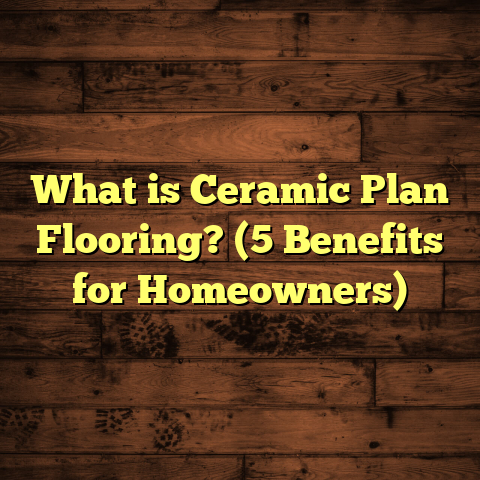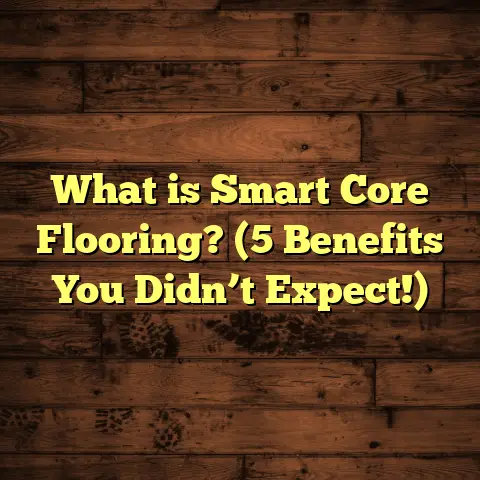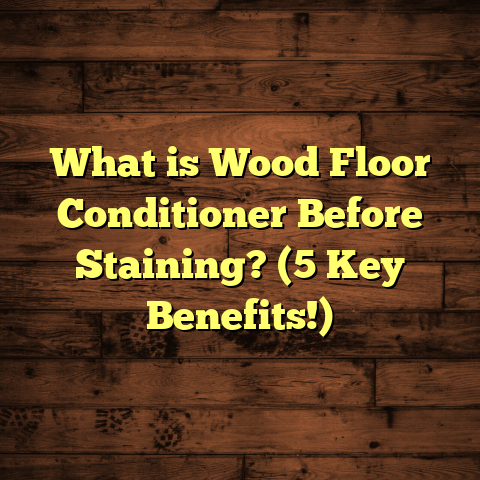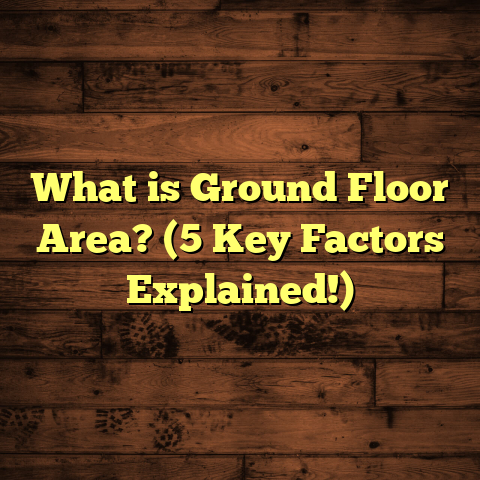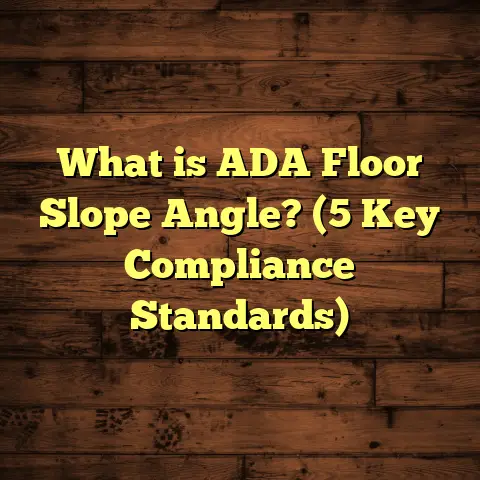What is a Cheap Floor Covering? (5 Budget-Friendly Options)
Accessibility and Affordable Flooring Choices
When I first started working in flooring, I met so many people who had one thing in common — they wanted a fresh floor that looked good but didn’t cost an arm and a leg. It’s a feeling I know well because I’ve renovated my own homes on tight budgets several times. Flooring is often one of the most expensive parts of home improvement, yet it’s one of the most visible.
That’s why I’m passionate about accessible, budget-friendly floor coverings. These are options that anyone can afford without feeling like they’re sacrificing quality or style. Over the years, I’ve tried countless materials and methods, learning what works best for different situations and budgets.
If you’re wondering what makes a floor covering cheap but still good, or which types can fit your lifestyle and space without breaking your budget, you’re in the right place. I’ll walk you through the top options I’ve used, with real numbers, practical tips, and honest pros and cons.
What Is a Cheap Floor Covering?
Let’s start with the basics. A cheap floor covering is simply a flooring material or product that costs less than traditional, high-end flooring options like solid hardwood or natural stone. But don’t confuse “cheap” with “low quality.” Instead, think of it as affordable flooring that offers decent durability, appearance, and ease of installation for a fraction of the price.
How Do We Define “Cheap” in Flooring?
From my experience working with homeowners and contractors across many projects, the “cheap” category usually means:
- Material plus installation costs around $2 to $5 per square foot.
- The product is widely available and doesn’t require specialized labor or tools.
- The floor performs adequately for its intended use — no immediate wear or damage after installation.
- It offers some aesthetic appeal—enough to look nice in your home without screaming “budget.”
For example, solid hardwood floors often cost $8 to $15 per square foot installed, sometimes more depending on species and finish. Tile with natural stone or high-end ceramics can easily reach $10+ per square foot installed. So anything under $5 per square foot feels like a better deal for those watching their spending.
Why Does This Matter?
I always ask clients what their priorities are for flooring: Is it longevity? Style? Easy cleaning? Or just cost? Because those answers help decide if cheap flooring is the right fit or if stretching the budget makes sense.
For instance:
- If you want a floor that lasts decades and increases home value, some investment upfront pays off.
- If you’re renting or planning to move soon, cheap but decent floors make more sense.
Understanding this helps me guide you toward affordable options that won’t feel like a compromise.
My Top 5 Budget-Friendly Flooring Options
I’ve installed floors in my own homes and helped clients pick materials for all kinds of spaces — from busy kitchens to cozy basements. These five options stand out because they balance cost with quality and style.
1. Vinyl Sheet and Vinyl Plank Flooring
Vinyl flooring has come a long way from the linoleum sheets of decades past. Today’s vinyl planks can mimic wood grain or stone textures so well most people don’t realize it’s vinyl until they get close.
Why I Like Vinyl
- Pricing: Installed vinyl plank floors typically run between $2 and $4 per square foot, making them one of the cheapest options that still offer water resistance and durability.
- Durability: I’ve seen vinyl floors last 10+ years in busy households. They resist scratches from pets and moisture from spills better than laminate or hardwood.
- Installation: Many vinyl planks use click-lock systems. I installed a 300 sq. ft. kitchen floor myself over a weekend with minimal tools and zero professional help. The total material cost was around $900.
Personal Story: My Kitchen Vinyl Project
One time, I decided to replace worn-out tiles in my kitchen with vinyl planks after water damage caused grout issues. It was my first DIY flooring project. The installation wasn’t perfect (some edges needed trimming), but the overall look was like engineered hardwood at a fraction of the price. Over two years later, the floor still looks great despite spills, dropped utensils, and kids running around.
Things to Consider
While vinyl is tough, it can dent under heavy furniture or sharp objects if not protected with pads. Also, newer vinyl products are much better in terms of chemical safety, but airing out a new floor is still a good idea.
2. Laminate Flooring
I have a soft spot for laminate because it feels like wood without the price tag or maintenance headaches.
Cost and Performance
Laminate costs about $1.50 to $3 per square foot installed depending on brand and style. It has a tough melamine topcoat that resists scratches well but isn’t waterproof unless specially treated.
Why I Recommend Laminate
- Aesthetics: Laminate comes in tons of wood-look finishes that look quite convincing from across the room.
- Installation: Click-lock planks make DIY installation straightforward for someone with basic skills. I installed laminate in my basement last year to cover cold concrete; it transformed the space instantly.
- Wear: It’s ideal for low-moisture areas like living rooms and bedrooms.
Caution on Moisture
Laminate’s Achilles heel is moisture. In bathrooms or damp basements without proper sealing or underlayment, laminate can warp or swell quickly.
3. Carpet Tiles
Carpet still has its place — especially carpet tiles which offer flexibility not found in traditional rolls.
Why Carpet Tiles?
- Cost: They run about $2 to $4 per square foot installed depending on quality.
- Maintenance: If a tile gets stained or worn out, you can replace just that section instead of ripping up the entire floor.
- Comfort: Carpet adds warmth and sound absorption that hard floors often lack.
My Experience Using Carpet Tiles
A client wanted noise reduction in her home office where she made calls all day. We installed carpet tiles on concrete subflooring to dampen sound without a huge expense. After two years, she replaced a few tiles where coffee spilled — easy and cheap!
Drawbacks
Carpet traps dust and allergens more than hard surfaces and needs regular vacuuming and occasional deep cleaning.
4. Peel-and-Stick Vinyl Tiles
For renters or quick fixes, peel-and-stick vinyl tiles are hard to beat.
Affordability and Simplicity
- Materials often cost less than $2 per square foot.
- No special tools required — just peel off backing and press tiles down on clean floors.
- Great for laundry rooms, small kitchens, or rental spaces where you don’t want permanent changes.
How I Used Peel-and-Stick Tiles
Helping a friend refresh her laundry room on a tight budget was fun because we finished it in an afternoon with just scissors and a roller tool to smooth out bubbles. Total spend: under $150 for 75 sq. ft.
Longevity Issues
These tiles aren’t as tough as glued-down vinyl or laminate; they may peel up over time in high-traffic spots.
5. Painted Plywood or Concrete Floors
If you want something truly cheap but effective, painting over existing plywood subfloors or concrete slabs is an option I’ve used myself.
Cost Breakdown
Expect to spend $0.50 to $1 per square foot on paint and prep materials like primer and sealant.
Benefits
- Full control over color and pattern
- Durable finishes with epoxy or porch paint
- Perfect for basements, garages, or casual rooms
Painting My Basement Floor
My basement was cold concrete with cracks when I moved in. I prepped it by filling cracks, then applied epoxy paint kits over several days (cost about $100 for 300 sq ft). The result was bright, clean-looking floors that resisted moisture well.
Prep Is Everything
If floors aren’t cleaned and prepped properly before painting, peeling will happen fast. Also, painted floors aren’t cushioned like carpet or laminate.
Comparing These Options: What Works Best?
After testing all these options across different rooms and budgets, here’s a detailed comparison based on my hands-on experience with data from manufacturers and clients:
| Flooring Type | Cost (per sq. ft.) | Durability | Installation Difficulty | Water Resistance | Maintenance Needs | Best Use Cases |
|---|---|---|---|---|---|---|
| Vinyl Sheet & Plank | $2 – $4 | High (8-12 yrs) | Moderate | Excellent | Low (wipe clean) | Kitchens, baths, entryways |
| Laminate | $1.50 – $3 | Medium (5-7 yrs) | Moderate | Low | Moderate (dry mop) | Living rooms, bedrooms |
| Carpet Tiles | $2 – $4 | Medium (5-8 yrs) | Easy | Low | High (vacuum/clean) | Offices, bedrooms |
| Peel-and-Stick Vinyl | <$2 (materials) | Low-Medium (3-5 yrs) | Very Easy | Medium | Low | Rentals, laundry rooms |
| Painted Plywood/Concrete | $0.50 – $1 | Medium (5 yrs) | Moderate | Medium | Moderate | Basements, garages |
Diving Deeper: Installation Tips I’ve Learned
Installation quality makes or breaks any floor covering’s performance over time. Here are some lessons from my years handling floors:
For Vinyl Planks:
- Always let vinyl acclimate in the room for 48 hours before installation to prevent buckling.
- Use underlayment recommended by manufacturers for extra cushioning.
- Keep expansion gaps around edges to allow natural movement.
For Laminate:
- Ensure subfloor is level; any bumps show through laminate.
- Lay vapor barrier if installing over concrete slabs.
- Don’t install laminate directly on carpet — never works well.
For Carpet Tiles:
- Clean subfloor thoroughly before laying tiles.
- Use pressure-sensitive adhesive if recommended for extra hold.
- Plan tile layout so seams fall in low traffic areas.
For Peel-and-Stick Tiles:
- Floor must be very clean and smooth; even small debris causes tiles to lift.
- Press tiles firmly to ensure good adhesion.
- Avoid wet rooms unless manufacturer states tiles are waterproof.
For Painted Floors:
- Fill cracks with epoxy filler before painting.
- Use multiple coats of primer plus paint for best durability.
- Seal painted floors with polyurethane clear coats if possible.
Maintenance: Keeping Cheap Floors Looking Great
Each flooring type requires different care to last long without expensive repairs:
| Flooring Type | Regular Cleaning | Stain Removal | Repairs |
|---|---|---|---|
| Vinyl | Sweep & mop with mild cleaner | Wipe spills immediately | Replace damaged planks if possible |
| Laminate | Dry mop or vacuum | Blot spills quickly | Replace planks if warped |
| Carpet Tiles | Vacuum daily | Spot clean stains | Swap out damaged tiles easily |
| Peel-and-Stick | Sweep & mop gently | Clean spills immediately | Replace lifted tiles |
| Painted Floors | Sweep & mop | Clean stains promptly | Repaint small patches |
Real Numbers: Cost Breakdown Examples From My Projects
Here are typical costs including materials and labor when I’ve hired pros or DIY’d:
Vinyl Plank Kitchen (200 sq ft):
Materials: $600 ($3/sq ft)
Tools & Supplies: $100
Labor (DIY): Free
Total: $700
Laminate Basement Floor (300 sq ft):
Materials: $450 ($1.50/sq ft)
Tools & Supplies: $150
Labor (DIY): Free
Total: $600
Carpet Tiles Home Office (150 sq ft):
Materials: $350 ($2.33/sq ft)
Installation by contractor: $250
Total: $600
Peel-and-Stick Laundry Room (75 sq ft):
Materials: $125 ($1.65/sq ft)
Installation DIY: Free
Total: $125
Painted Concrete Basement Floor (300 sq ft):
Materials: $100 ($0.33/sq ft)
Prep supplies: $60
Labor DIY: Free
Total: $160
Seeing these numbers side-by-side helped me decide when it’s worth paying more for durability versus saving upfront for short-term needs.
What Others Are Saying: Case Studies From Homeowners
Case Study 1: Family With Kids Chooses Vinyl Planks
The Johnson family replaced their old carpet with vinyl planks in their kitchen/dining area after spills became a nightmare to clean up. They spent about $1,200 on materials/installation for 400 sq ft but loved how easy it is to wipe up messes now. After 3 years it still looks great despite heavy use.
Case Study 2: Renter Uses Peel-and-Stick Tiles
Sara lives in an apartment where she can’t change flooring permanently but wanted fresh floors in her kitchen area. She spent less than $150 on peel-and-stick tiles she installed herself over a weekend. While not perfect long-term, they brighten her space at very low cost.
Case Study 3: DIY Painted Basement Floor Saves Thousands
Mike and Lisa had a concrete basement floor they hated but couldn’t afford new flooring yet. They spent about $200 total painting it with epoxy kits themselves instead of paying thousands for new tile or laminate. It improved the look dramatically and held up well through two winters.
Frequently Asked Questions About Cheap Flooring
Q: Will cheap flooring lower my home’s value?
A: Not necessarily — if the floor looks nice and functions well it won’t hurt resale values much, especially if you plan to upgrade later.
Q: How long do cheap floors last?
A: Generally between 5 to 12 years depending on type and wear conditions.
Q: Can I install these floors myself?
A: Many budget options like vinyl planks, laminate, carpet tiles, and peel-and-stick tiles are designed for DIY installation if you have basic tools.
Q: What about environmental impact?
A: Some budget flooring contains PVC or other plastics; look for low-VOC products labeled GreenGuard or FloorScore if this concerns you.
Wrapping Up My Thoughts on Cheap Floor Coverings
Affordable flooring doesn’t mean settling for ugly or short-lived materials anymore — many budget options today offer excellent looks at prices anyone can afford. From vinyl planks that handle kitchen spills like champs to carpet tiles that make repairs simple, there’s something for every style and need.
I hope sharing my hands-on experience helps you feel confident choosing floors that work for your space without overspending.
If you want more detailed advice based on your specific room dimensions, foot traffic levels, or style preferences, just ask! Helping friends pick smart flooring solutions is what I enjoy most.
What kind of space are you thinking about updating? I’m happy to share even more insights tailored to your plans.
